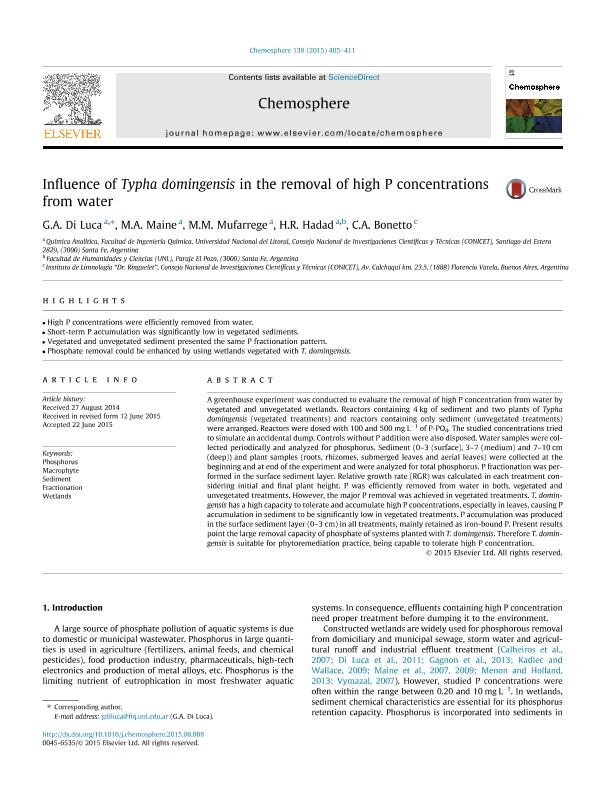Mostrar el registro sencillo del ítem
dc.contributor.author
Di Luca, Gisela Alfonsina

dc.contributor.author
Maine, Maria Alejandra

dc.contributor.author
Mufarrege, María de Las Mercedes

dc.contributor.author
Hadad, Hernán Ricardo

dc.contributor.author
Bonetto, Carlos Alberto

dc.date.available
2017-09-01T12:55:25Z
dc.date.issued
2015-11
dc.identifier.citation
Di Luca, Gisela Alfonsina; Maine, Maria Alejandra; Mufarrege, María de Las Mercedes; Hadad, Hernán Ricardo; Bonetto, Carlos Alberto; Influence of Typha domingensis in the removal on high P concentrations from water; Elsevier; Chemosphere; 138; 11-2015; 405-411
dc.identifier.issn
0045-6535
dc.identifier.uri
http://hdl.handle.net/11336/23424
dc.description.abstract
A greenhouse experiment was conducted to evaluate the removal of high P concentration from water by vegetated and unvegetated wetlands. Reactors containing 4 Kg of sediment and two plants of Typha domingensis (vegetated treatments) and reactors containing only sediment (unvegetated treatments) were arranged. Reactors were dosed with 100 and 500 mg L-1 of P-PO4. The studied concentrations tried to simulate an accidental dump. Controls without P addition were also disposed. Water samples were collected periodically and analyzed for phosphorus. Sediment (0-3 (surface), 3-7 (medium) and 7-10cm (deep)) and plant samples (roots, rhizomes, submerged leaves and aerial leaves) were collected at the beginning and at end of the experiment and were analyzed for total phosphorus. P fractionation was performed in the surface sediment layer. Relative growth rate (RGR) was calculated in each treatment considering initial and final plant height. P was efficiently removed from water in both, vegetated and unvegetated treatments. However, the major P removal was achieved in vegetated treatments. T. domingensis has a high capacity to tolerate and accumulate high P concentrations, especially in leaves, causing P accumulation in sediment to be significantly low in vegetated treatments. P accumulation was produced in the surface sediment layer (0-3cm) in all treatments, mainly retained as iron-bound P. Present results point the large removal capacity of phosphate of systems planted with T. domingensis. Therefore T. domingensis is suitable for phytoremediation practice, being capable to tolerate high P concentration.
dc.format
application/pdf
dc.language.iso
eng
dc.publisher
Elsevier

dc.rights
info:eu-repo/semantics/openAccess
dc.rights.uri
https://creativecommons.org/licenses/by-nc-sa/2.5/ar/
dc.subject
Phosphorus
dc.subject
Macrophyte
dc.subject
Sediment
dc.subject
Fractionation
dc.subject
Wetlands
dc.subject.classification
Oceanografía, Hidrología, Recursos Hídricos

dc.subject.classification
Ciencias de la Tierra y relacionadas con el Medio Ambiente

dc.subject.classification
CIENCIAS NATURALES Y EXACTAS

dc.title
Influence of Typha domingensis in the removal on high P concentrations from water
dc.type
info:eu-repo/semantics/article
dc.type
info:ar-repo/semantics/artículo
dc.type
info:eu-repo/semantics/publishedVersion
dc.date.updated
2017-08-07T18:44:15Z
dc.journal.volume
138
dc.journal.pagination
405-411
dc.journal.pais
Países Bajos

dc.journal.ciudad
Amsterdam
dc.description.fil
Fil: Di Luca, Gisela Alfonsina. Universidad Nacional del Litoral. Facultad de Ingeniería Química. Laboratorio de Química Analítica; Argentina. Consejo Nacional de Investigaciones Científicas y Técnicas; Argentina
dc.description.fil
Fil: Maine, Maria Alejandra. Universidad Nacional del Litoral. Facultad de Ingeniería Química. Laboratorio de Química Analítica; Argentina. Consejo Nacional de Investigaciones Científicas y Técnicas; Argentina
dc.description.fil
Fil: Mufarrege, María de Las Mercedes. Consejo Nacional de Investigaciones Científicas y Técnicas. Centro Científico Tecnológico Conicet - la Plata; Argentina. Universidad Nacional del Litoral. Facultad de Ingeniería Química. Laboratorio de Química Analítica; Argentina
dc.description.fil
Fil: Hadad, Hernán Ricardo. Universidad Nacional del Litoral. Facultad de Ingeniería Química. Laboratorio de Química Analítica; Argentina. Consejo Nacional de Investigaciones Científicas y Técnicas; Argentina
dc.description.fil
Fil: Bonetto, Carlos Alberto. Consejo Nacional de Investigaciones Científicas y Técnicas. Centro Científico Tecnológico Conicet - La Plata. Instituto de Limnología "Dr. Raúl A. Ringuelet". Universidad Nacional de La Plata. Facultad de Ciencias Naturales y Museo. Instituto de Limnología; Argentina
dc.journal.title
Chemosphere

dc.relation.alternativeid
info:eu-repo/semantics/altIdentifier/url/http://www.sciencedirect.com/science/article/pii/S0045653515006876
dc.relation.alternativeid
info:eu-repo/semantics/altIdentifier/doi/http://dx.doi.org/10.1016/j.chemosphere.2015.06.068
Archivos asociados
